Examining the Economic and Environmental Impacts of COVID-19 Using Earth Observation Data
Abstract
1. Introduction
2. Data and Methodology
Materials and Methods
3. Results—Effects of Lockdown
3.1. Population Density
3.2. Variations in Mobility Patterns
3.3. Analysis of NO2
3.4. Distribution of Nighttime Lights (NTL)
4. Discussion and Conclusions
Author Contributions
Funding
Data Availability Statement
Acknowledgments
Conflicts of Interest
References
- Hui, D.S.; Azhar, E.I.; Madani, T.A.; Ntoumi, F.; Kock, R.; Dar, O.; Ippolito, G.; Mchugh, T.D.; Memish, Z.A.; Drosten, C.; et al. The continuing 2019-nCoV epidemic threat of novel coronaviruses to global health—The latest 2019 novel coronavirus outbreak in Wuhan, China. Int. J. Infect. Dis. 2020, 91, 264–652. [Google Scholar] [CrossRef] [PubMed]
- Paules, C.I.; Marston, H.D.; Fauci, A.S. Coronavirus Infections—More Than Just the Common Cold. JAMA 2020, 323, 707. [Google Scholar] [CrossRef]
- Li, Q.; Guan, X.; Wu, P.; Wang, X.; Zhou, L.; Tong, Y.; Ren, R.; Leung, K.S.M.; Lau, E.H.Y.; Wong, J.Y.; et al. Early Transmission Dynamics in Wuhan, China, of Novel Coronavirus–Infected Pneumonia. N. Engl. J. Med. 2020, 382, 1199–1207. [Google Scholar] [CrossRef] [PubMed]
- Wong, J.; Goh, Q.Y.; Tan, Z.; Lie, S.A.; Tay, Y.C.; Ng, S.Y.; Soh, C.R. Preparing for a COVID-19 pandemic: A review of operating room outbreak response measures in a large tertiary hospital in Singapore. Can. J. Anesth. 2020, 67, 732–745. [Google Scholar] [CrossRef] [PubMed]
- World Health Organization (WHO). WHO Announces COVID-19 Outbreak a Pandemic. Available online: https://www.euro.who.int/en/health-topics/health-emergencies/coronavirus-CoVID-19/news/news/2020/3662/who-announces-CoVID-19-outbreak-a-pandemic (accessed on 19 September 2020).
- Johns Hopkins University of Medicine (JHU), COVID-19 Data in Motion. Available online: https://coronavirus.jhu.edu/ (accessed on 19 September 2020).
- Strochlic, N.; Champine, R.D. How Some Cities ‘Flattened the Curve’ during the 1918 Flu Pandemic. National Geographic. Available online: https://www.nationalgeographic.com/history/2020/03/how-cities-flattened-curve-1918-spanish-flu-pande668mic-coronavirus/ (accessed on 19 September 2020).
- Sharma, S.; Zhang, M.; Anshika; Gao, J.; Zhang, H.; Kota, S.H. Effect of restricted emissions during COVID-19 on air quality in India. Sci. Total Environ. 2020, 728, 138878. [Google Scholar] [CrossRef]
- U.S. Bureau of Economic Analysis. CAGDP2 Gross Domestic Product (GDP) by County and Metropolitan Area. Available online: https://apps.bea.gov/itable/iTable.cfm?ReqID=70&step=1 (accessed on 19 September 2020).
- Bonaccorsi, G.; Pierri, F.; Cinelli, M.; Flori, A.; Galeazzi, A.; Porcelli, F.; Schmidt, A.L.; Valensise, C.M.; Scala, A.; Quattrociocchi, W.; et al. Economic and social consequences of human mobility restrictions under COVID-19. Proc. Natl. Acad. Sci. USA 2020, 117, 15530–15535. [Google Scholar] [CrossRef]
- Chen, S.; Igan, D.; Pierri, N.; Presbitero, A. The Economic Impact of COVID-19 in Europe and the US: Outbreaks and Individual Behaviour Matter a Great Deal, Non-Pharmaceutical Interventions Matter Less. VOXEU-CEPR. Available online: https://voxeu.org/article/economic-impact-CoVID-19-europe-and-us (accessed on 19 September 2020).
- Huang, J.; Wang, H.; Xiong, H.; Fan, M.; Zhou, A.; Li, Y.; Dou, D. Quantifying the Economic Impact of 681 COVID-19 in Mainland China Using Human Mobility Data. Available online: https://arxiv.org/abs/2005.03010 (accessed on 19 September 2020).
- Lamsal, L.N.; Martin, R.V.; Parrish, D.D.; Krotkov, N.A. Scaling Relationship for NO2 Pollution and Urban Population Size: A Satellite Perspective. Environ. Sci. Technol. 2013, 47, 7855–7861. [Google Scholar] [CrossRef]
- Bauwens, M.; Compernolle, S.; StavrakouiD, T.; Müllerid, J.-F.; Van Gent, J.; Eskes, H.; Levelt, P.F.; Van Der, A.R.; Veefkind, J.P.; Vlietinck, J.; et al. Impact of Coronavirus Outbreak on NO 2 Pollution Assessed Using TROPOMI and OMI Observations. Geophys. Res. Lett. 2020, 47, 688. [Google Scholar] [CrossRef]
- Shi, X.; BrasseuriD, G.P. The Response in Air Quality to the Reduction of Chinese Economic Activities during the COVID-19 Outbreak. Geophys. Res. Lett. 2020, 47, 691. [Google Scholar] [CrossRef]
- He, G.; Pan, Y.; Tanaka, T. The short-term impacts of COVID-19 lockdown on urban air pollution in China. Nat. Sustain. 2020, 3, 1005–1011. [Google Scholar] [CrossRef]
- Mahato, S.; Pal, S.; Ghosh, K.G. Effect of lockdown amid COVID-19 pandemic on air quality of the megacity Delhi, India. Sci. Total Environ. 2020, 730, 139086. [Google Scholar] [CrossRef] [PubMed]
- Kumari, P.; Toshniwal, D. Impact of lockdown measures during COVID-19 on air quality– A case study of India. Int. J. Environ. Health Res. 2020, 1–8. [Google Scholar] [CrossRef] [PubMed]
- UNECE. Declines in air Pollution Due to COVID-19 Lockdown Show Need for Comprehensive Emission Reduction Strategies. UNECE Sustainable Development GOALS. Available online: https://www.unece.org/info/media/news/environment/2020/declines-in-air-pollution-due-to-CoVID-19-lolockdown-show-need-for-comprehensive-emission-reduction-strategies/doc.html (accessed on 19 September 2020).
- Ogen, Y. Assessing nitrogen dioxide (NO2) levels as a contributing factor to coronavirus (COVID-19) fatality. Sci. Total Environ. 2020, 726, 138605. [Google Scholar] [CrossRef] [PubMed]
- Wu, X.; Nethery, R.C.; Sabath, M.B.; Braun, D.; Dominici, F. Air pollution and COVID-19 mortality in the United States: Strengths and limitations of an ecological regression analysis. Sci. Adv. 2020, 6, eabd4049. [Google Scholar] [CrossRef]
- American Lung Association. State of the Air 2020. American Lung Association. Available online: https://wtop.com/wp-content/uploads/2020/04/SOTA-2020-Proof-8-Embargoed.pdf (accessed on 19 September 2020).
- Veefkind, J.; Aben, E.; McMullan, K.; Förster, H.; De Vries, J.; Otter, G.; Claas, J.; Eskes, H.; De Haan, J.; Kleipool, Q.; et al. TROPOMI on the ESA Sentinel-5 Precursor: A GMES mission for global observations of the atmospheric composition for climate, air quality and ozone layer applications. Remote Sens. Environ. 2012, 120, 70–83. [Google Scholar] [CrossRef]
- Lee, T.E.; Miller, S.D.; Turk, F.J.; Schueler, C.; Julian, R.; Deyo, S.; Dills, P.; Wang, S. The NPOESS VIIRS Day/Night Visible Sensor. Bull. Am. Meteorol. Soc. 2006, 87, 191–200. [Google Scholar] [CrossRef]
- Liao, L.B.; Weiss, S.; Mills, S.; Hauss, B. Suomi NPP VIIRS Day and Night Band (DNB) on-orbit performance. J. Geophys. Res. Atmos. 2013, 118, 12705–12718. [Google Scholar] [CrossRef]
- Mills, S.; Jacobson, E.; Jaron, J.; McCarthy, J.; Ohnuki, T.; Plonski, M.; Searcy, D.; Weiss, S. Calibration of the VIIRS Day/Night Band (DNB). Remote Sens. 2015, 7, 718–988. [Google Scholar]
- Jacobson, E.; Ibara, A.; Lucas, M.; Menzel, R.; Murphey, H.; Yin, F.; Yokoyama, K. Operation and characterization of the Day/Night Band (DNB) for the NPP Visible/Infrared Imager Radiometer Suite (VIIRS). In Proceedings of the 6th Annual Symposium on Future National Operational Environmental Satellite Systems-NPOESS and GOES-R, Boston, MA, USA, 20 January 2010; p. 349. [Google Scholar]
- Straka, W.; Seaman, C.J.; Baugh, K.E.; Cole, K.; Stevens, E.; Miller, S.D. Utilization of the Suomi National Polar-Orbiting Partnership (NPP) Visible Infrared Imaging Radiometer Suite (VIIRS) Day/Night Band for Arctic Ship Tracking and Fisheries Management. Remote Sens. 2015, 7, 971–989. [Google Scholar] [CrossRef]
- Miller, S.D.; Straka, W.; Mills, S.P.; Elvidge, C.D.; Lee, T.F.; Solbrig, J.; Walther, A.; Heidinger, A.K.; Weiss, S.C. Illuminating the Capabilities of the Suomi National Polar-Orbiting Partnership (NPP) Visible Infrared Imaging Radiometer Suite (VIIRS) Day/Night Band. Remote Sens. 2013, 5, 6717–6766. [Google Scholar] [CrossRef]
- Bennett, M.M.; Smith, L.C. Advances in using multitemporal night-time lights satellite imagery to detect, estimate, and monitor socioeconomic dynamics. Remote Sens. Environ. 2017, 192, 176–197. [Google Scholar] [CrossRef]
- Elvidge, C.D.; Baugh, K.E.; Kihn, E.A.; Kroehl, H.W.; Davis, E.R.; Davis, C.W. Relation between satellite observed visible-near infrared emissions, population, economic activity and electric power consumption. Int. J. Remote Sens. 1997, 18, 1373–1379. [Google Scholar] [CrossRef]
- Jing, X.; Shao, X.; Cao, C.; Fu, X.; Yan, L. Comparison between the Suomi-NPP Day-Night Band and DMSP-OLS for Correlating Socio-Economic Variables at the Provincial Level in China. Remote Sens. 2016, 8, 17. [Google Scholar] [CrossRef]
- Yeh, C.; Perez, A.; Driscoll, A.; Azzari, G.; Tang, Z.; Lobell, D.; Ermon, S.; Burke, M. Using publicly available satellite imagery and deep learning to understand economic well-being in Africa. Nat. Commun. 2020, 11, 1–11. [Google Scholar] [CrossRef] [PubMed]
- Kopp, T.J.; Thomas, W.; Heidinger, A.K.; Botambekov, D.; Frey, R.A.; Hutchison, K.D.; Iisager, B.D.; Brueske, K.; Reed, B. The VIIRS Cloud Mask: Progress in the first year of S-NPP toward a common 741 cloud detection scheme. J. Geophys. Res. Atmos. 2014, 119, 2441–2456. [Google Scholar] [CrossRef]
- Mills, S.; Weiss, S.; Liang, C. VIIRS day/night band (DNB) stray light characterization and correction. In Proceedings of the Earth Observing Systems XVIII. SPIE Intl. Soc. Opt. Eng. 2013, 8866, 88661P. [Google Scholar]
- Lasry, A.; Kidder, D.; Hast, M.; Poovey, J.; Sunshine, G.; Zviedrite, N.; Ahmed, F.; Ethier, K.A. Timing of Community Mitigation and Changes in Reported COVID-19 and Community Mobility—Four US 746 Metropolitan Areas. MMWR Morb. Mortal. Wkly. Rep. 2020, 69, 451–457. [Google Scholar] [CrossRef]
- WorldPop. Mapping Populations—WorldPop Gridded Population Estimate Datasets and Tools. 2020. Available online: https://www.worldpop.org/methods/populations (accessed on 20 September 2020).
- Getis, A.; Ord, J.K. The Analysis of Spatial Association by Use of Distance Statistics. Geogr. Anal. 2010, 24, 189–206. [Google Scholar] [CrossRef]
- Ord, J.K.; Getis, A. Local Spatial Autocorrelation Statistics: Distributional Issues and an Application. Geogr. Anal. 1995, 27, 286–306. [Google Scholar] [CrossRef]
- ESRI. How Optimized Hot Spot Analysis Works. ESRI. 2020. Available online: https://pro.arcgis.com/en/pro-app/tool-reference/spatial-statistics/how-optimized-hot-spot-analysis-works.htm#:~:text=The%20Optimized%20Hot%20Spot%20Analysis%20tool%20identifies%20peak%20distances%20using,becomes%20the%20scale%20of%20analysis.&text=This%20distance%20corresponds%20to%20758the,Getis%2DOrd%20Gi*)%20tool (accessed on 20 September 2020).
- Anselin, L. Local Indicators of Spatial Association-LISA. Geogr. Anal. 1995, 27, 93–115. [Google Scholar] [CrossRef]
- Anselin, L.; Syabri, I.; Kho, Y. GeoDa: An Introduction to Spatial Data Analysis. Handb. Appl. Spat. Anal. 2010, 38, 73–89. [Google Scholar] [CrossRef]
- Anselin, L. The Moran Scatterplot as an ESDA Tool to Assess Local Instability in Spatial Association. In Spatial Analytical Perspectives on GIS; Informa UK Limited: London, UK, 2019; pp. 111–126. [Google Scholar]
- Goldberg, D.L.; Anenberg, S.C.; Griffin, D.; McLinden, C.A.; Lu, Z.; Streets, D.G. Disentangling the impact of the COVID-19 lockdowns on urban NO 2 from natural variability. Geophys. Res. Lett. 2020, 47, e2020GL089269. [Google Scholar] [CrossRef] [PubMed]
- Elvidge, C.D.; Ghosh, T.; Hsu, F.-C.; Zhizhin, M.; Bazilian, M. The Dimming of Lights in China during the COVID-19 Pandemic. Remote Sens. 2020, 12, 2851. [Google Scholar] [CrossRef]
- Connerton, P.; Vicente de Assunção, J.; Maura de Miranda, R.; Dorothée Slovic, A.; José Pérez-Martínez, P.; Ribeiro, H. Air quality during COVID-19 in four megacities: Lessons and challenges for public health. Int. J. Environ. Res. Public Health 2020, 17, 775. [Google Scholar] [CrossRef] [PubMed]
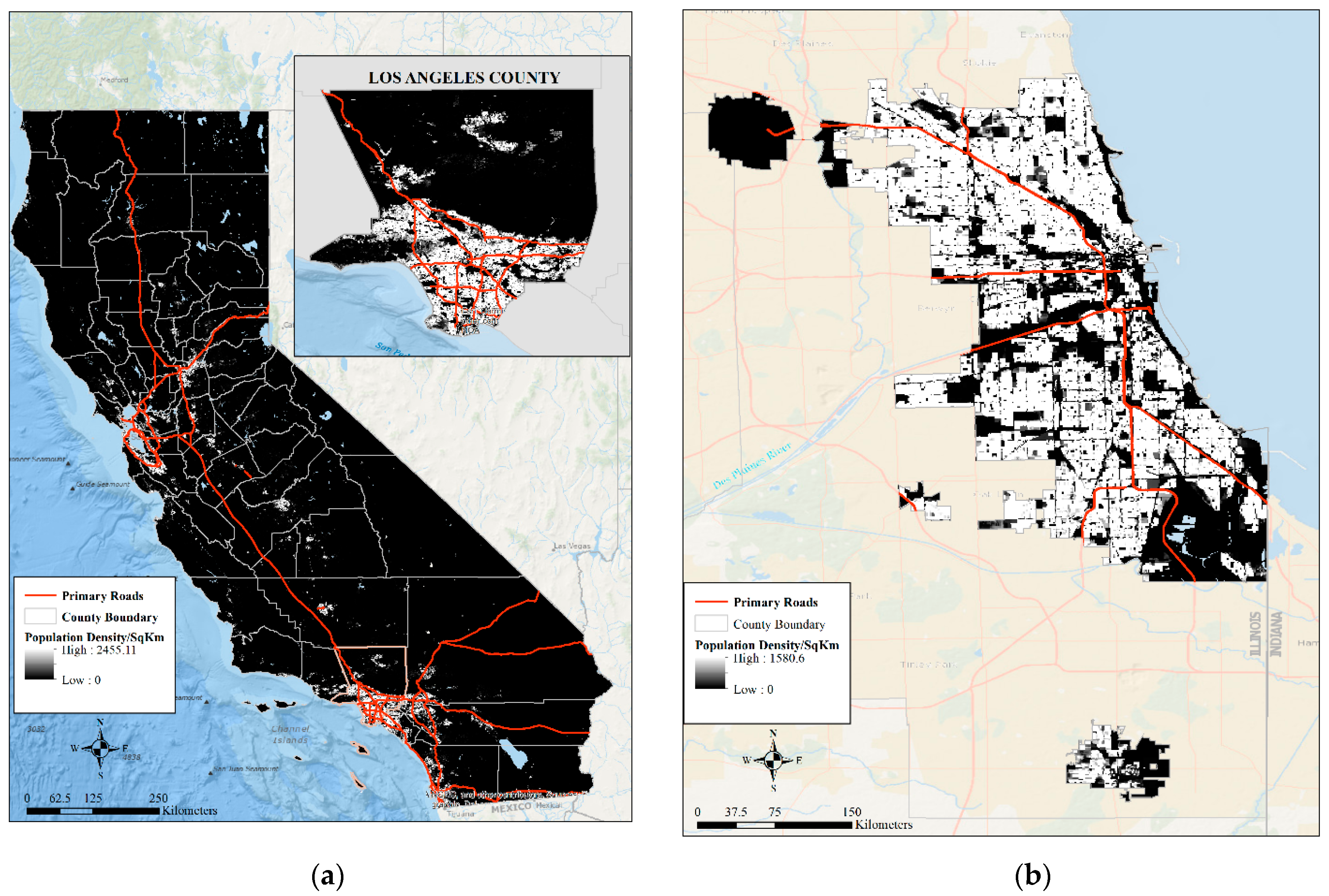
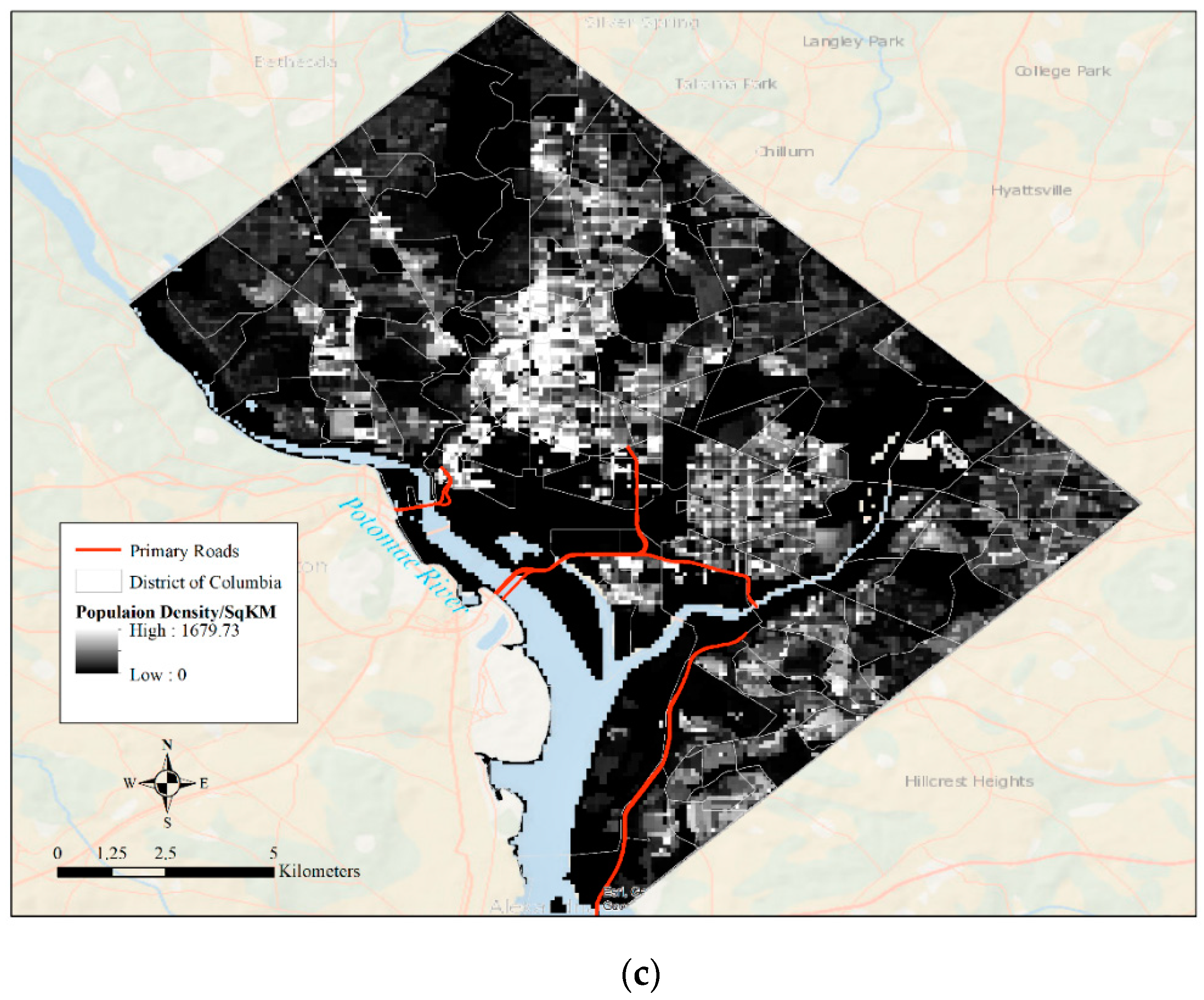
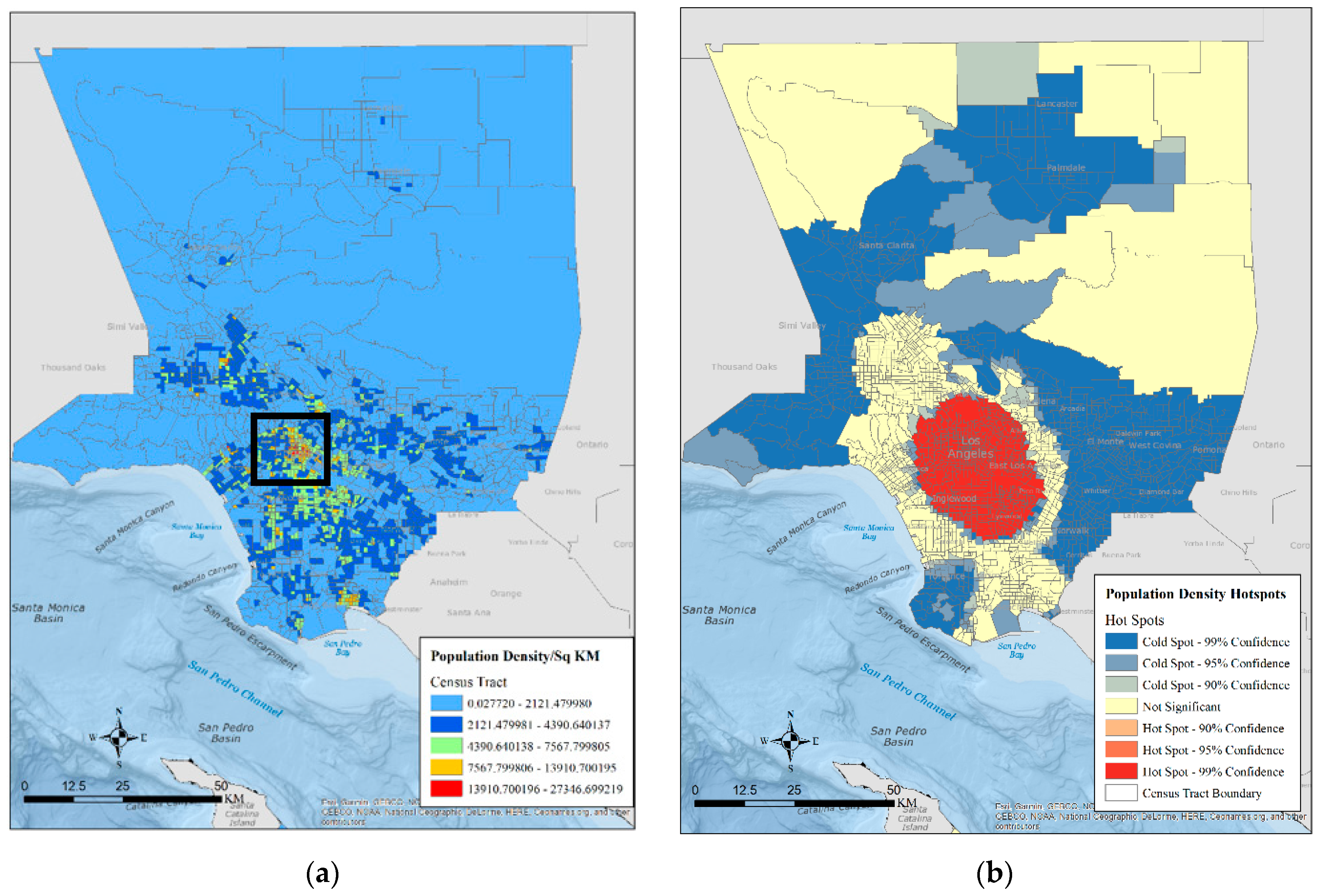

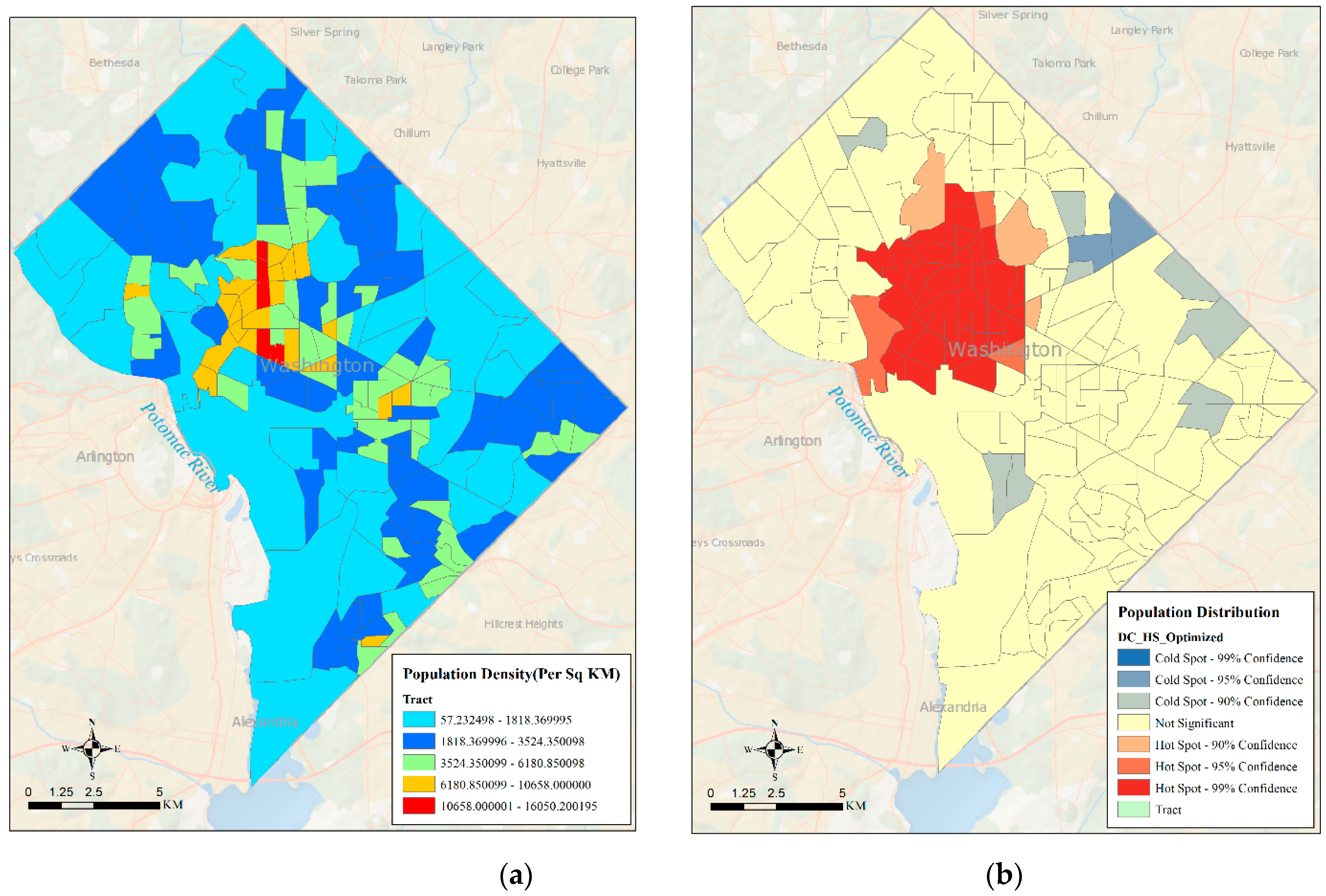

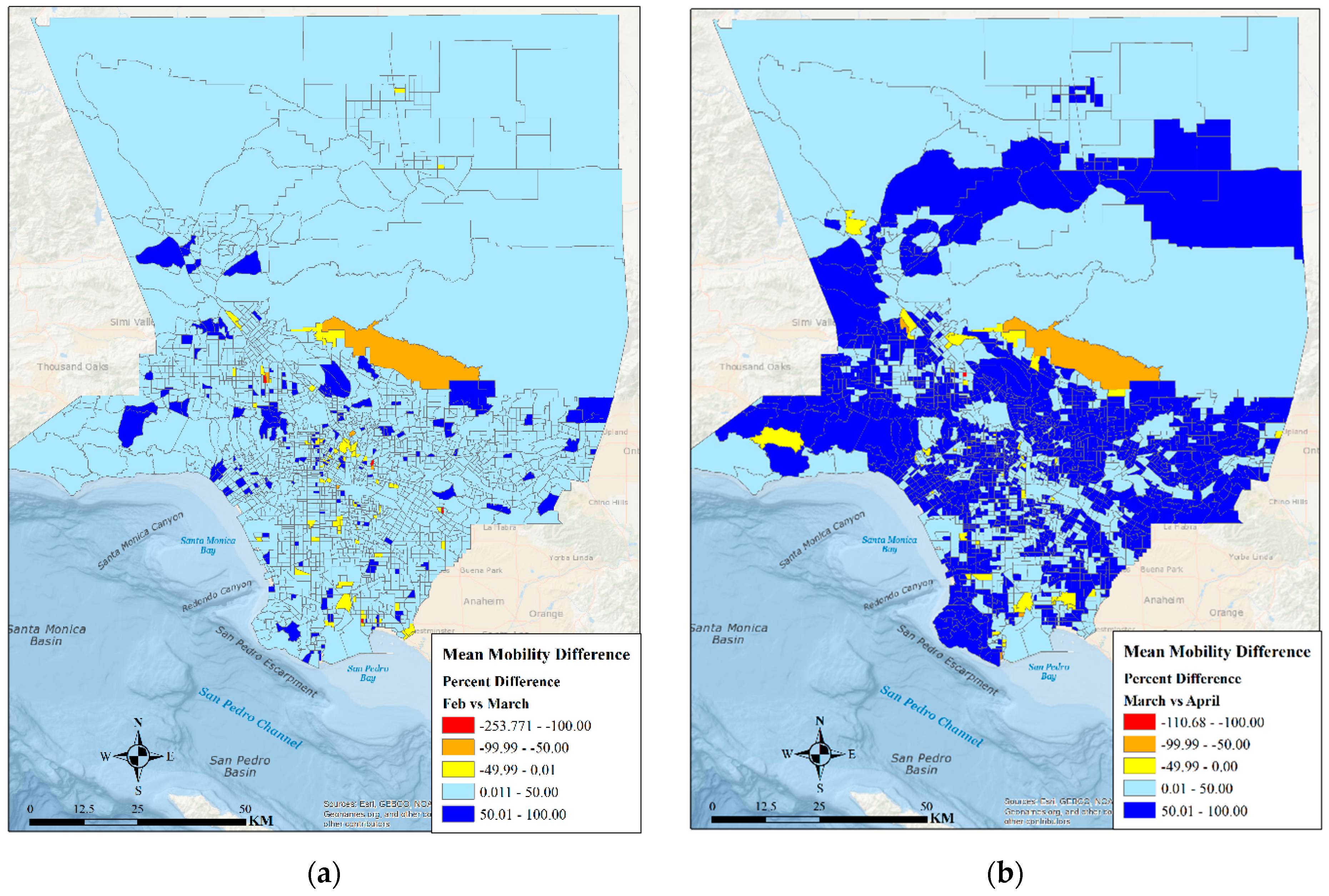
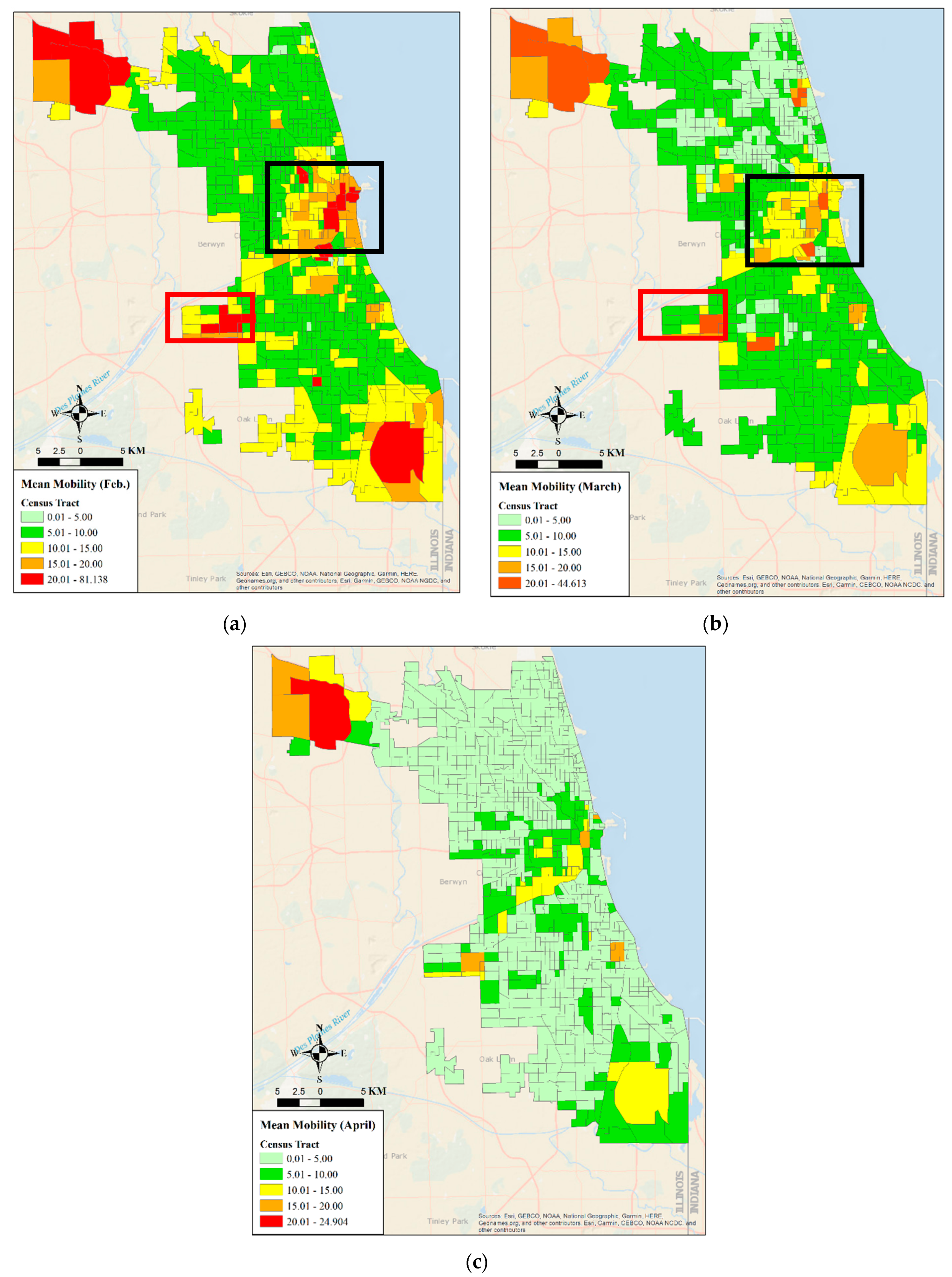
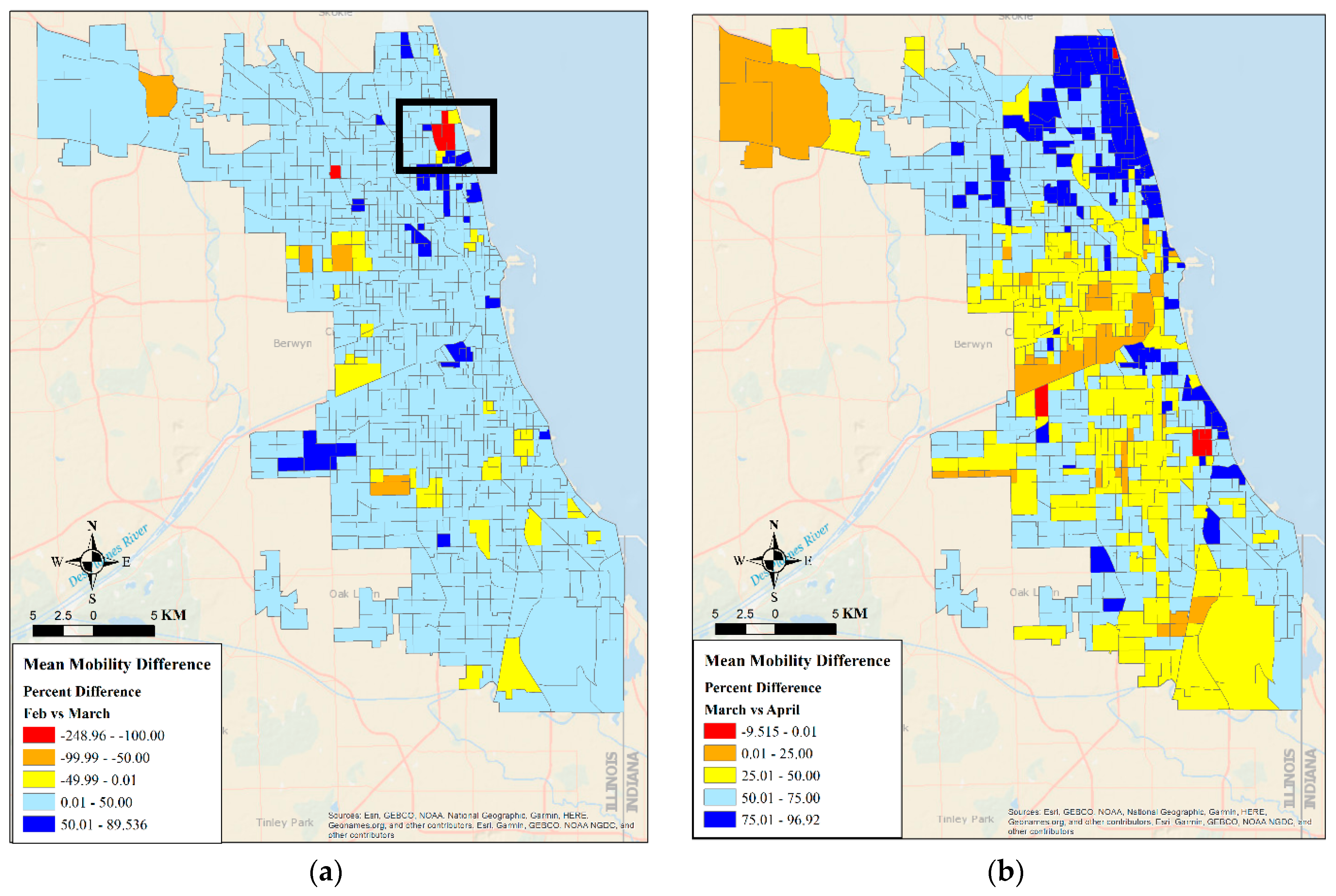
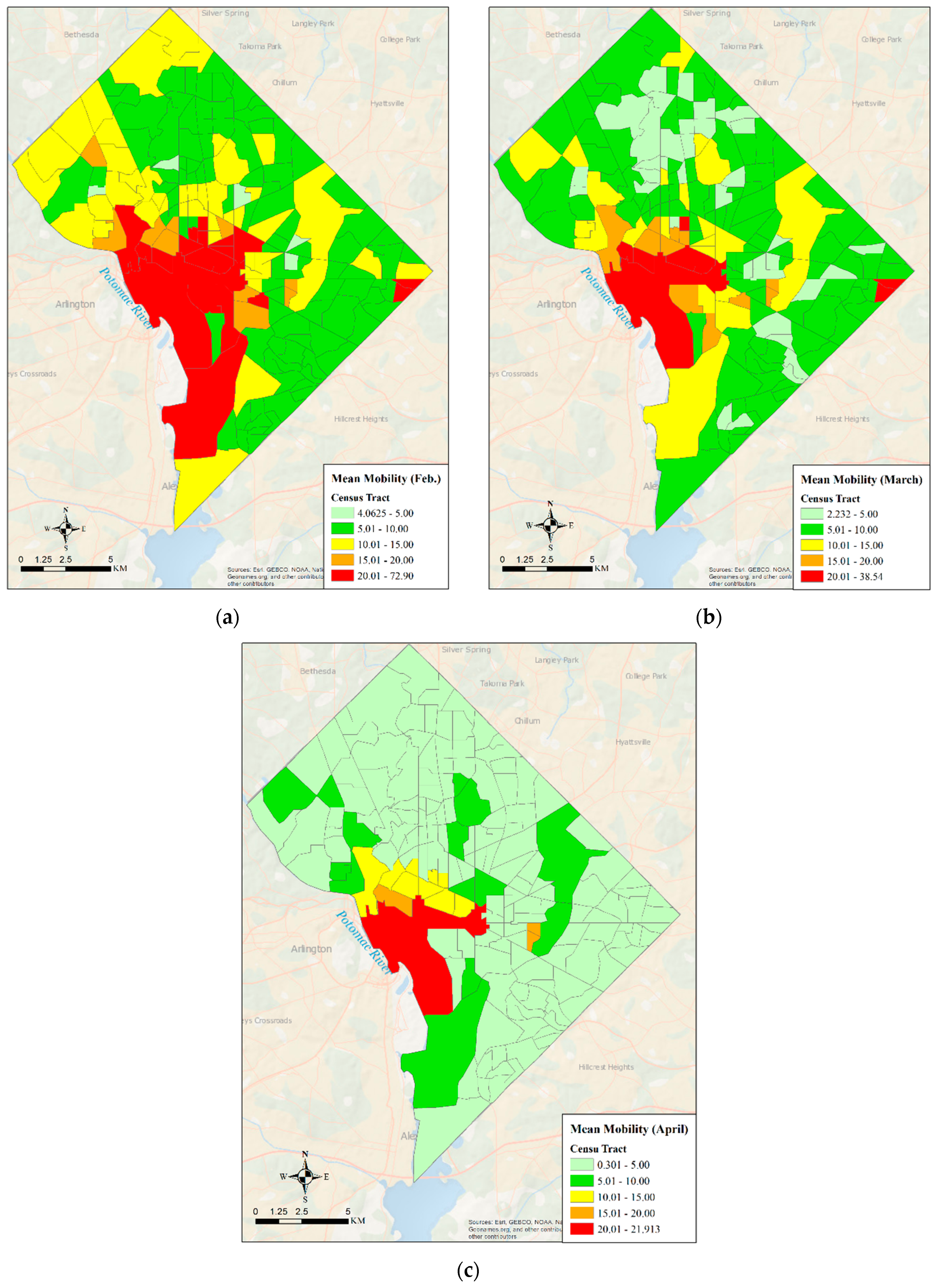
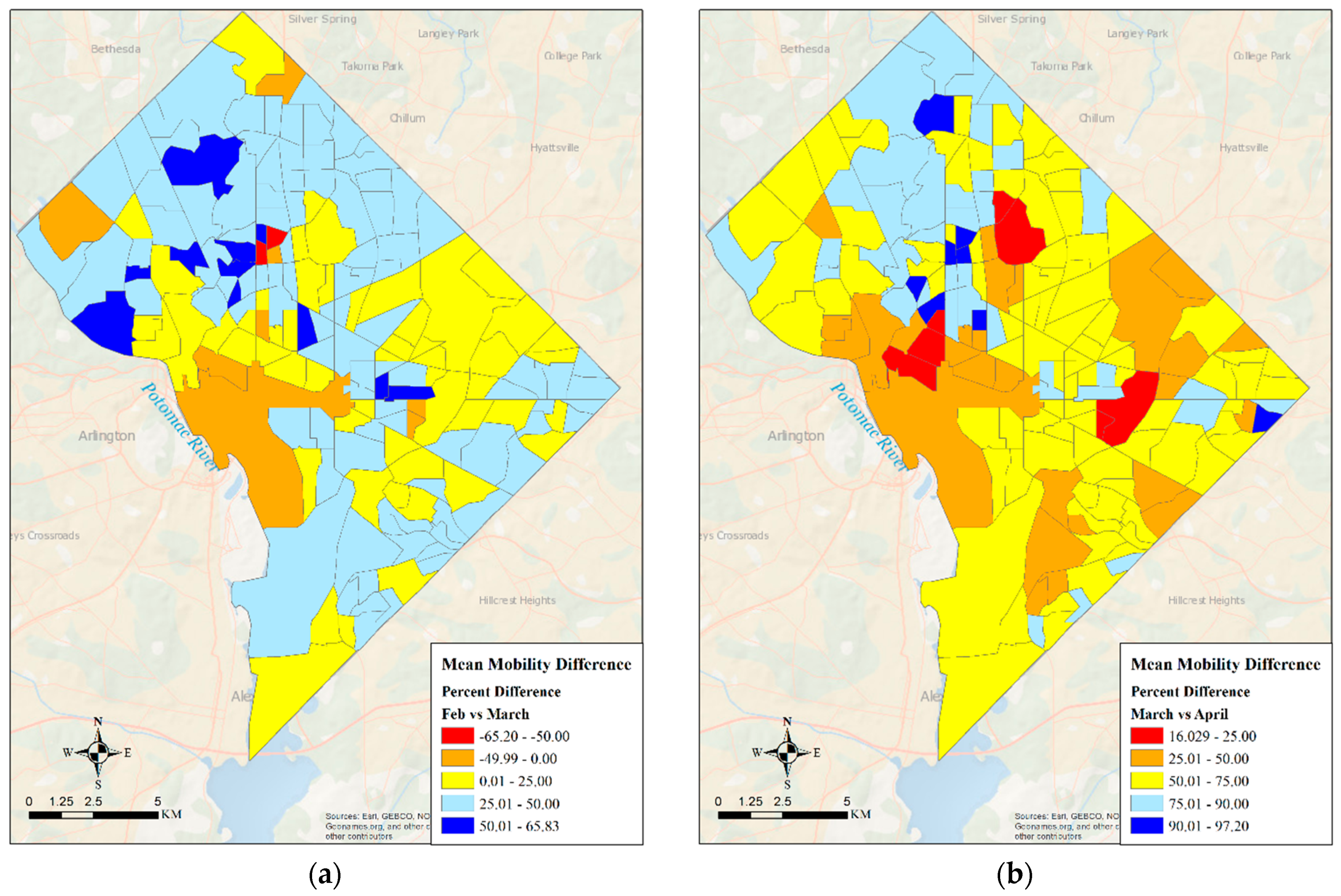
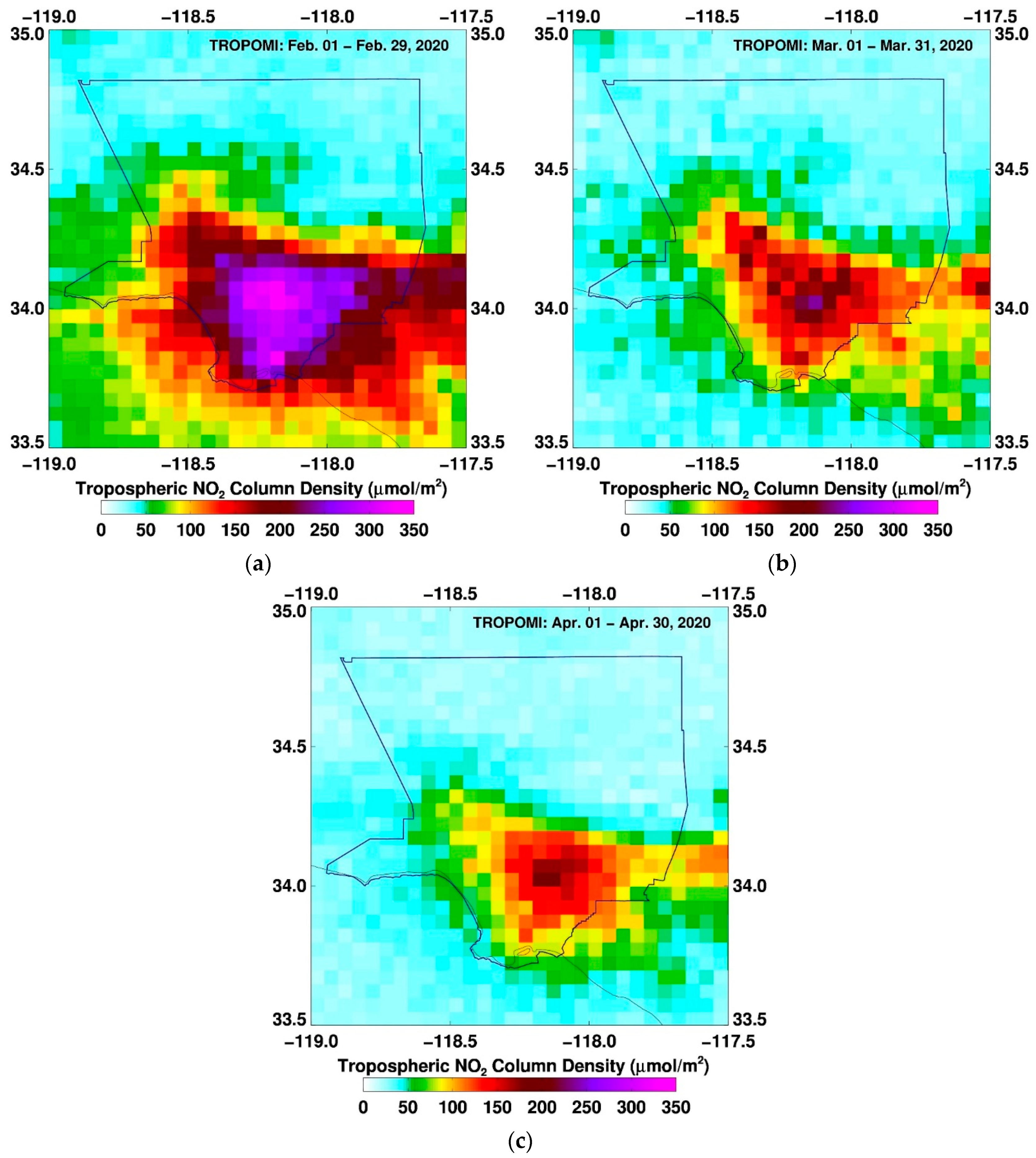
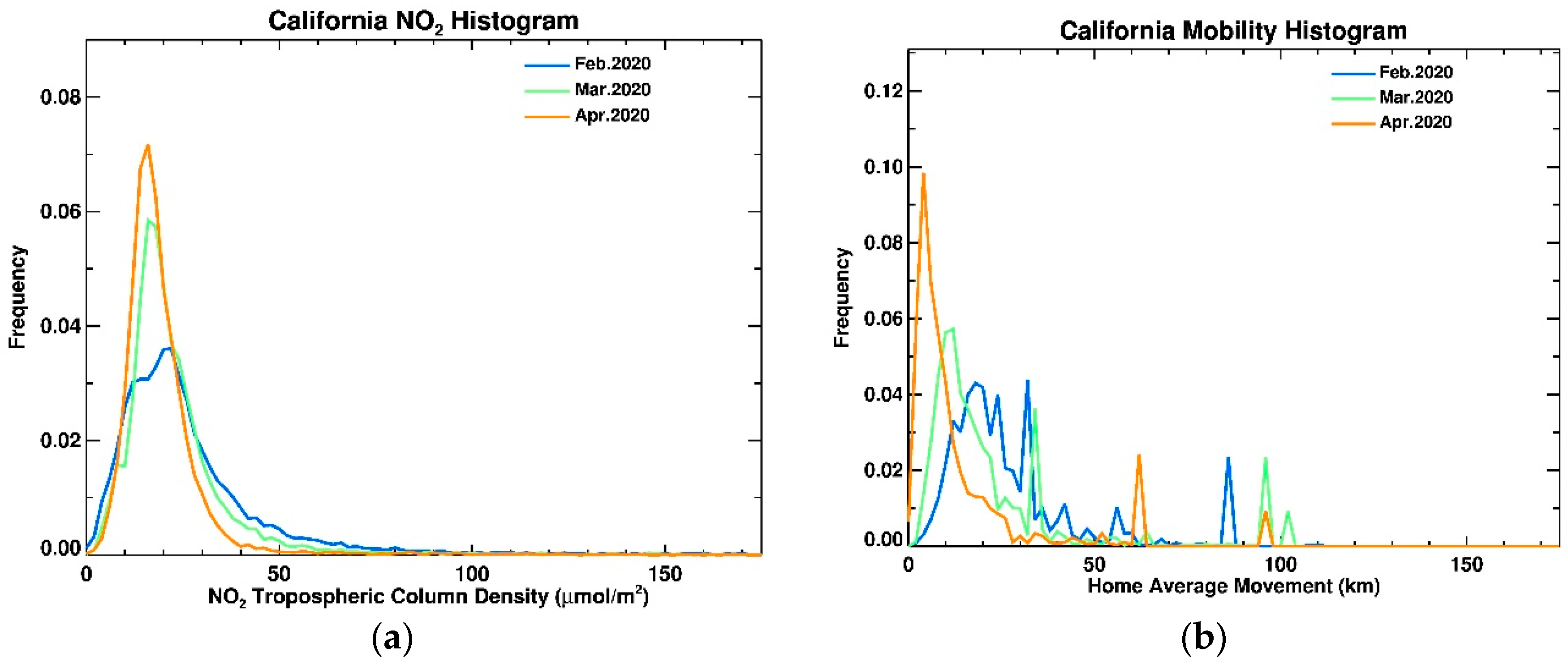

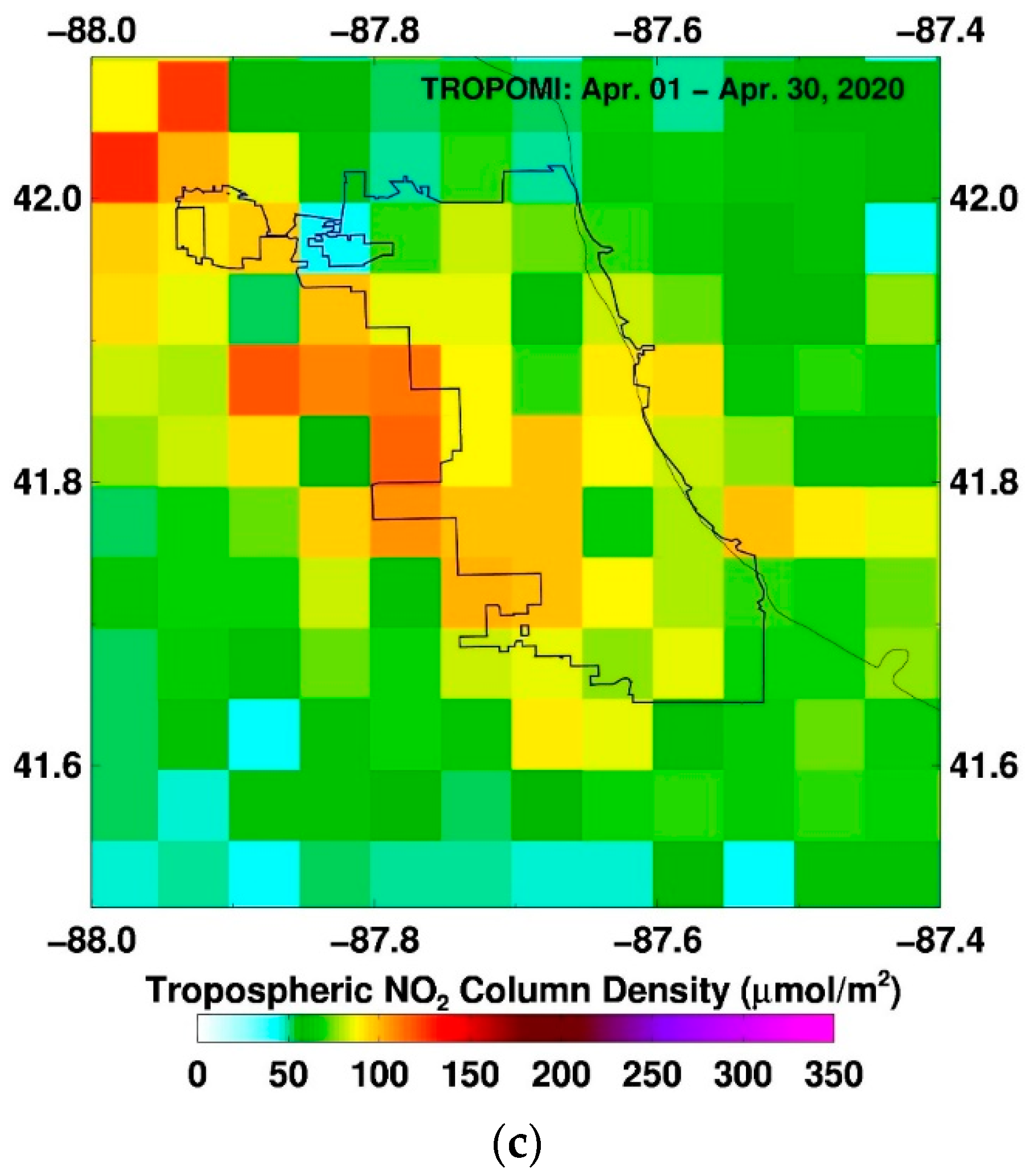
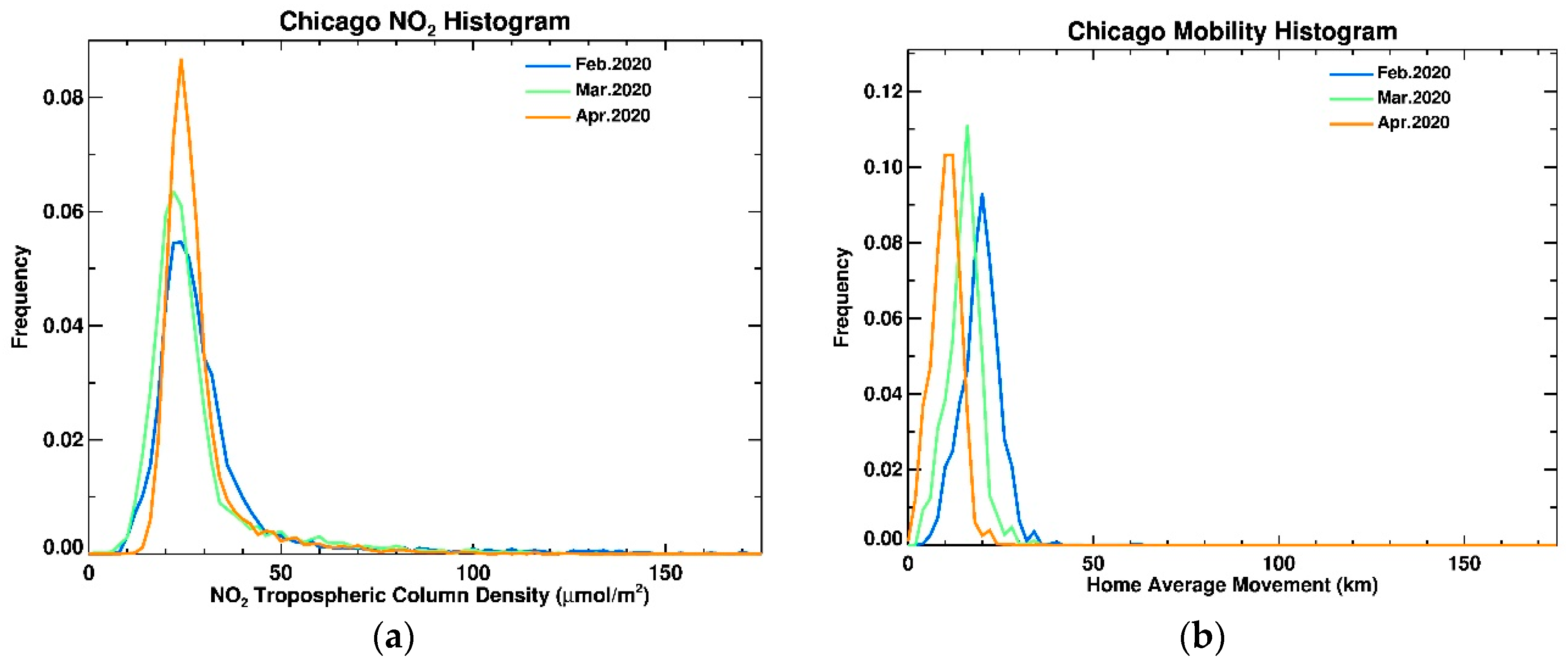
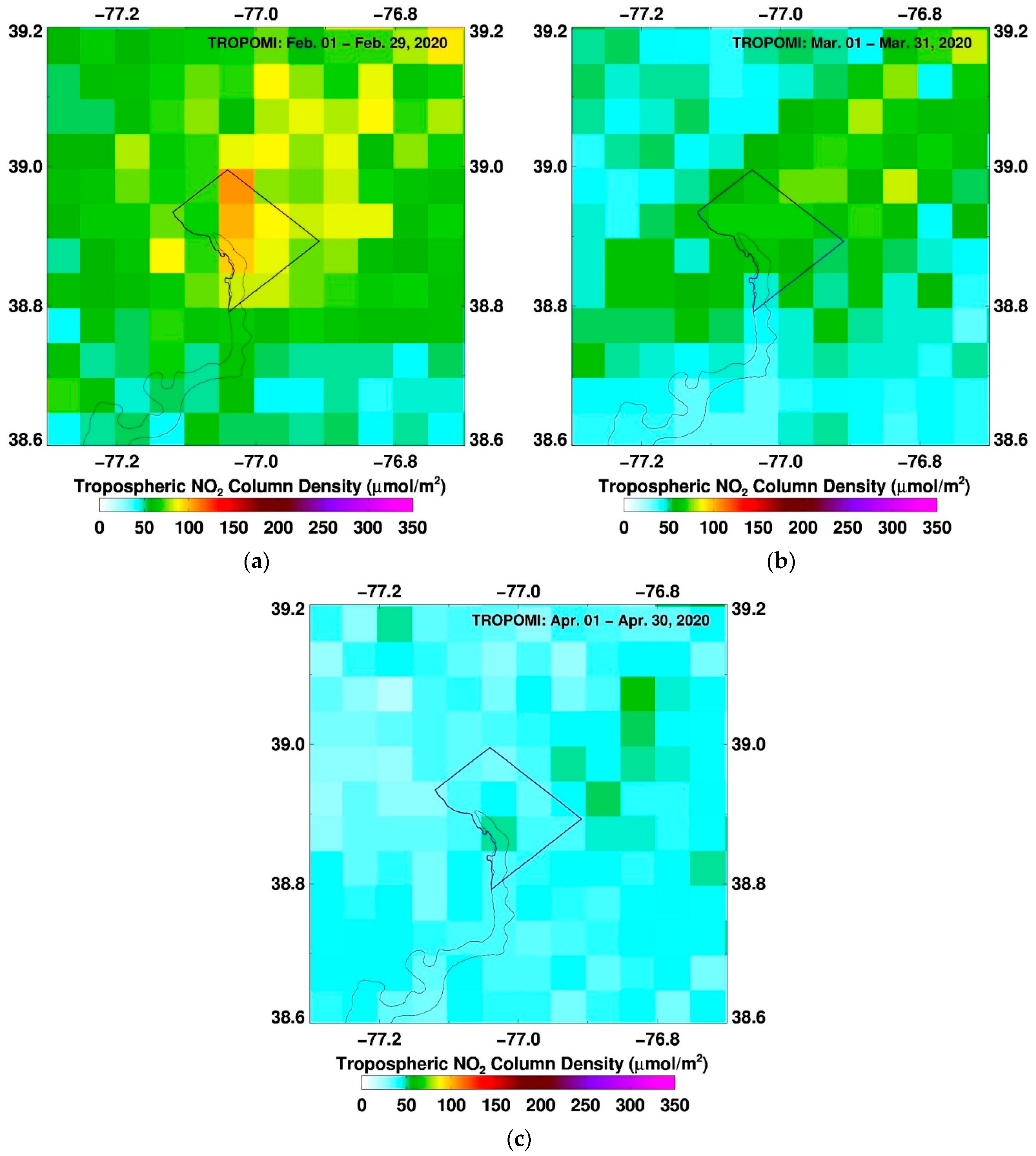
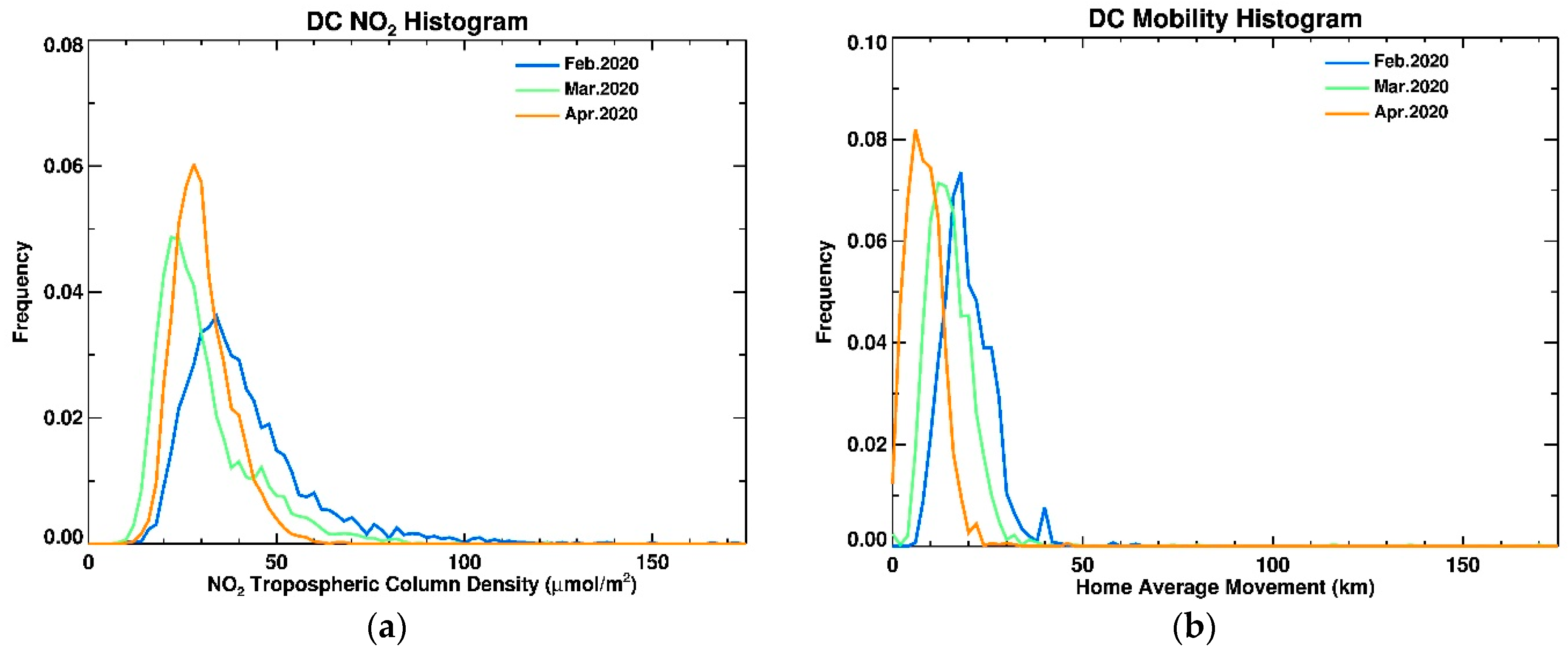
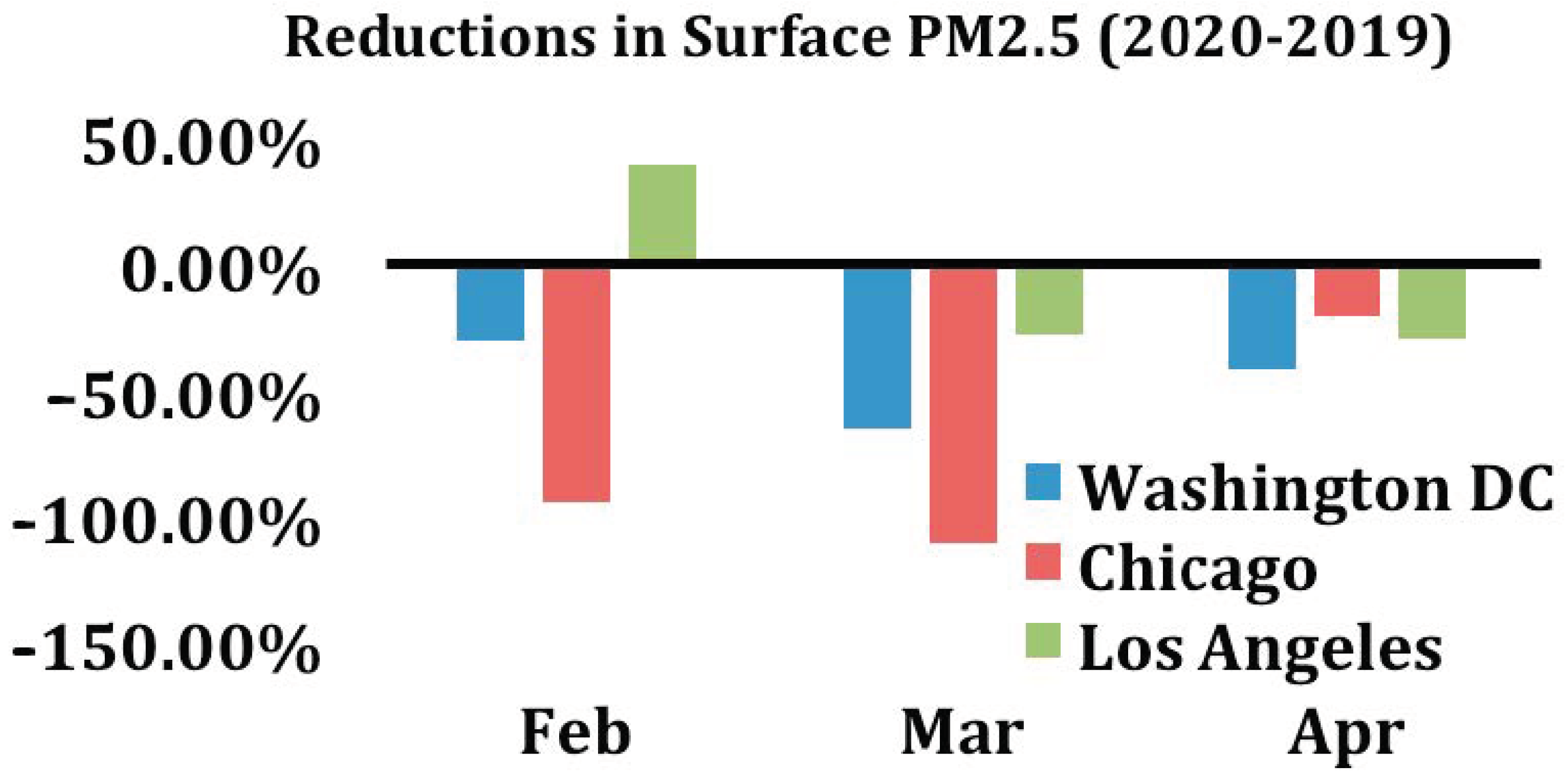
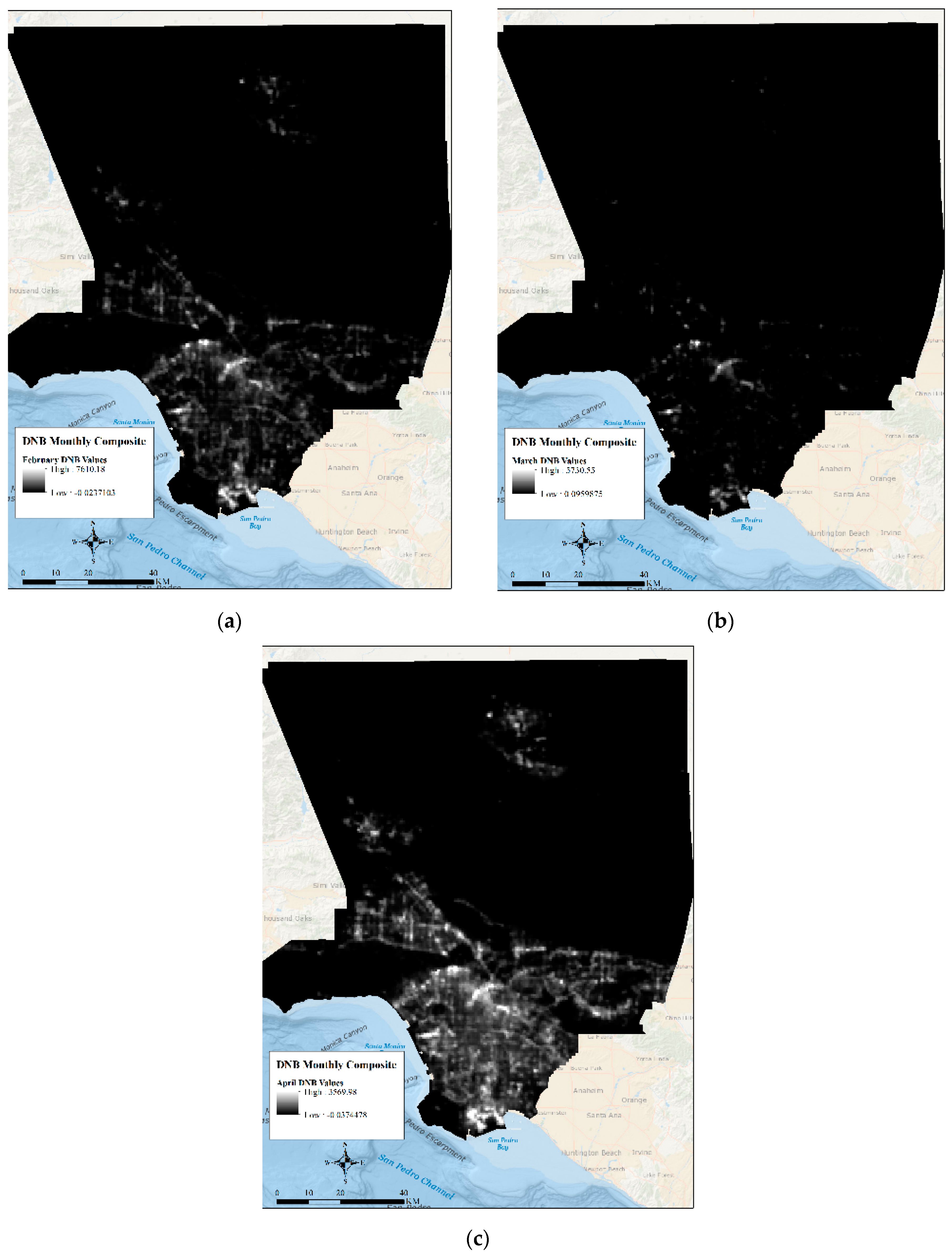
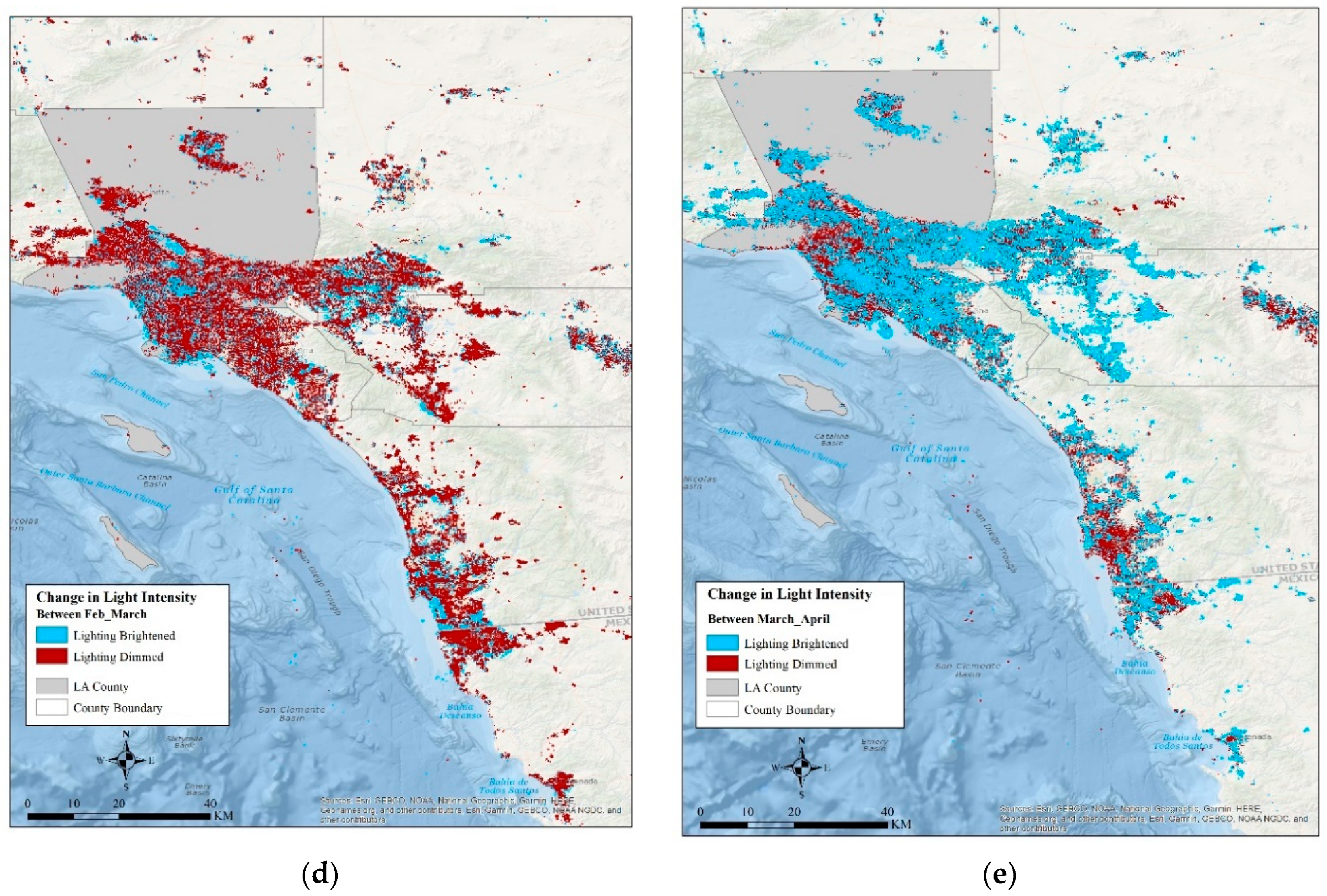
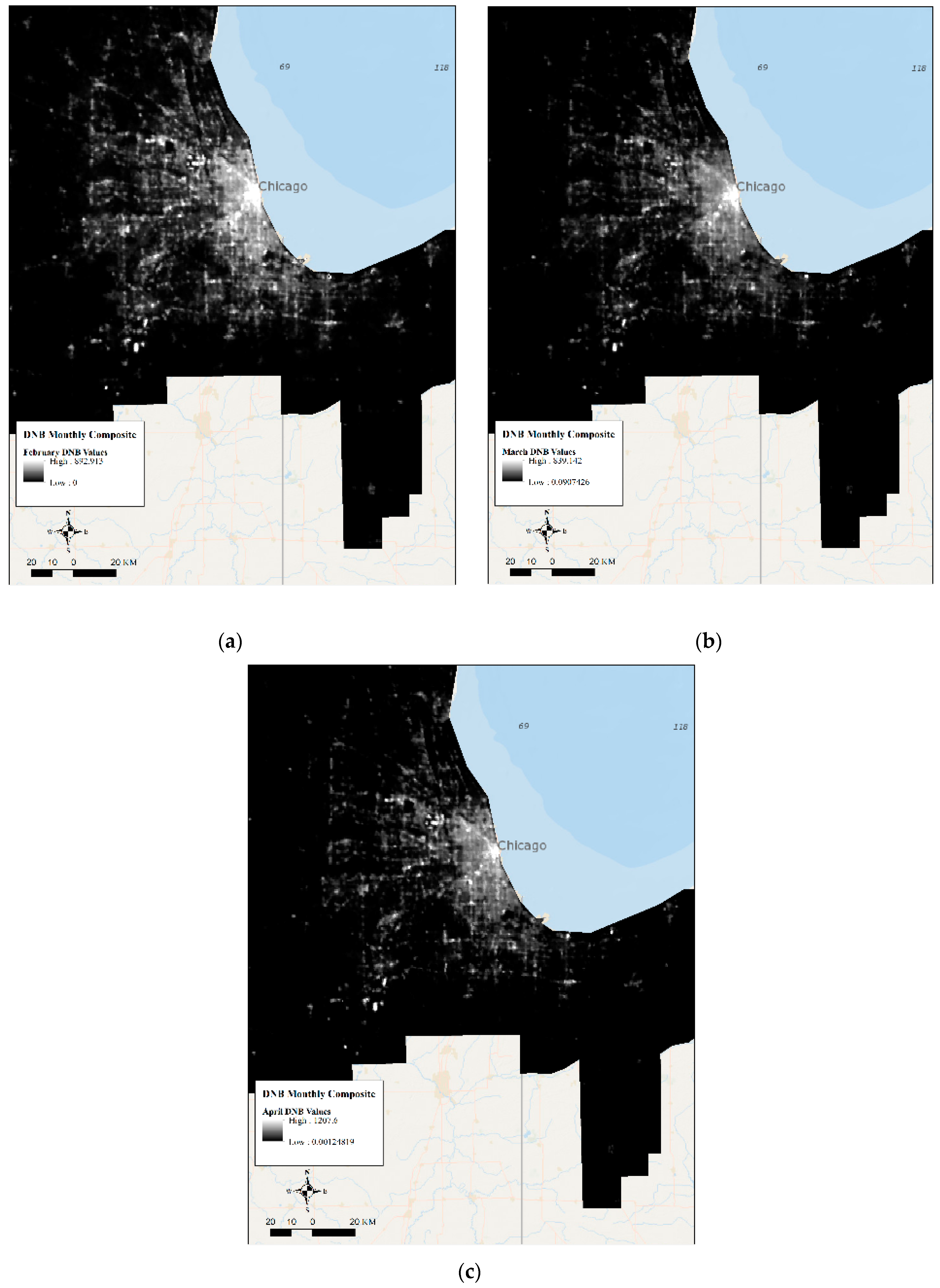

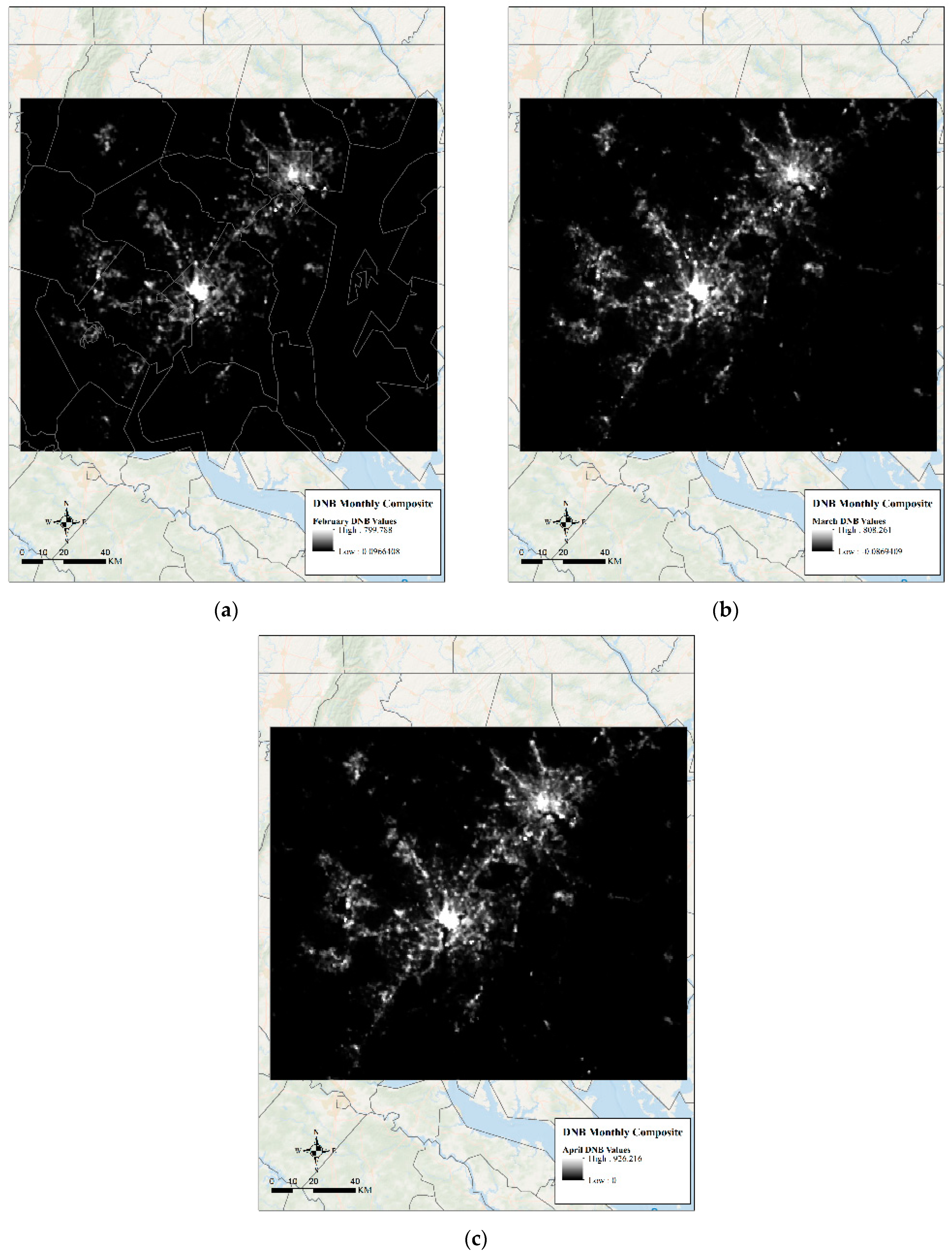
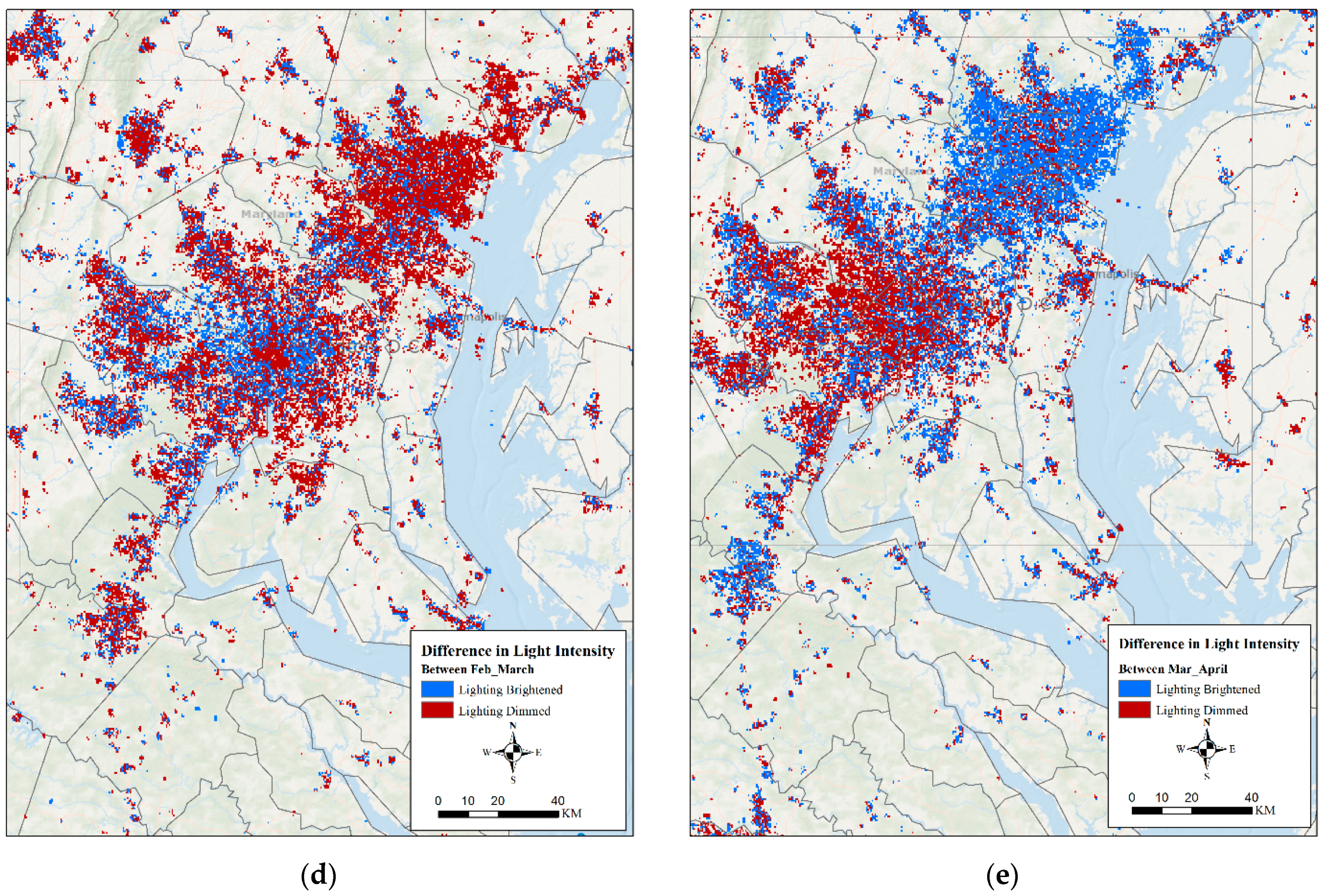
| NO2 (µmoles/m2) | Mobility (km) | |||||
|---|---|---|---|---|---|---|
| City | February | March | April | February | March | April |
| Washington, DC | 89.6 | 62.7 | 36.1 | 13.3 | 10.1 | 5.4 |
| Chicago | 123.9 | 102.7 | 82.1 | 12.4 | 9.2 | 5.4 |
| Los Angeles | 108.8 | 65.6 | 51.3 | 24.1 | 17.6 | 11.5 |
Publisher’s Note: MDPI stays neutral with regard to jurisdictional claims in published maps and institutional affiliations. |
© 2020 by the authors. Licensee MDPI, Basel, Switzerland. This article is an open access article distributed under the terms and conditions of the Creative Commons Attribution (CC BY) license (http://creativecommons.org/licenses/by/4.0/).
Share and Cite
Straka, W., III; Kondragunta, S.; Wei, Z.; Zhang, H.; Miller, S.D.; Watts, A. Examining the Economic and Environmental Impacts of COVID-19 Using Earth Observation Data. Remote Sens. 2021, 13, 5. https://doi.org/10.3390/rs13010005
Straka W III, Kondragunta S, Wei Z, Zhang H, Miller SD, Watts A. Examining the Economic and Environmental Impacts of COVID-19 Using Earth Observation Data. Remote Sensing. 2021; 13(1):5. https://doi.org/10.3390/rs13010005
Chicago/Turabian StyleStraka, William, III, Shobha Kondragunta, Zigang Wei, Hai Zhang, Steven D. Miller, and Alexander Watts. 2021. "Examining the Economic and Environmental Impacts of COVID-19 Using Earth Observation Data" Remote Sensing 13, no. 1: 5. https://doi.org/10.3390/rs13010005
APA StyleStraka, W., III, Kondragunta, S., Wei, Z., Zhang, H., Miller, S. D., & Watts, A. (2021). Examining the Economic and Environmental Impacts of COVID-19 Using Earth Observation Data. Remote Sensing, 13(1), 5. https://doi.org/10.3390/rs13010005






